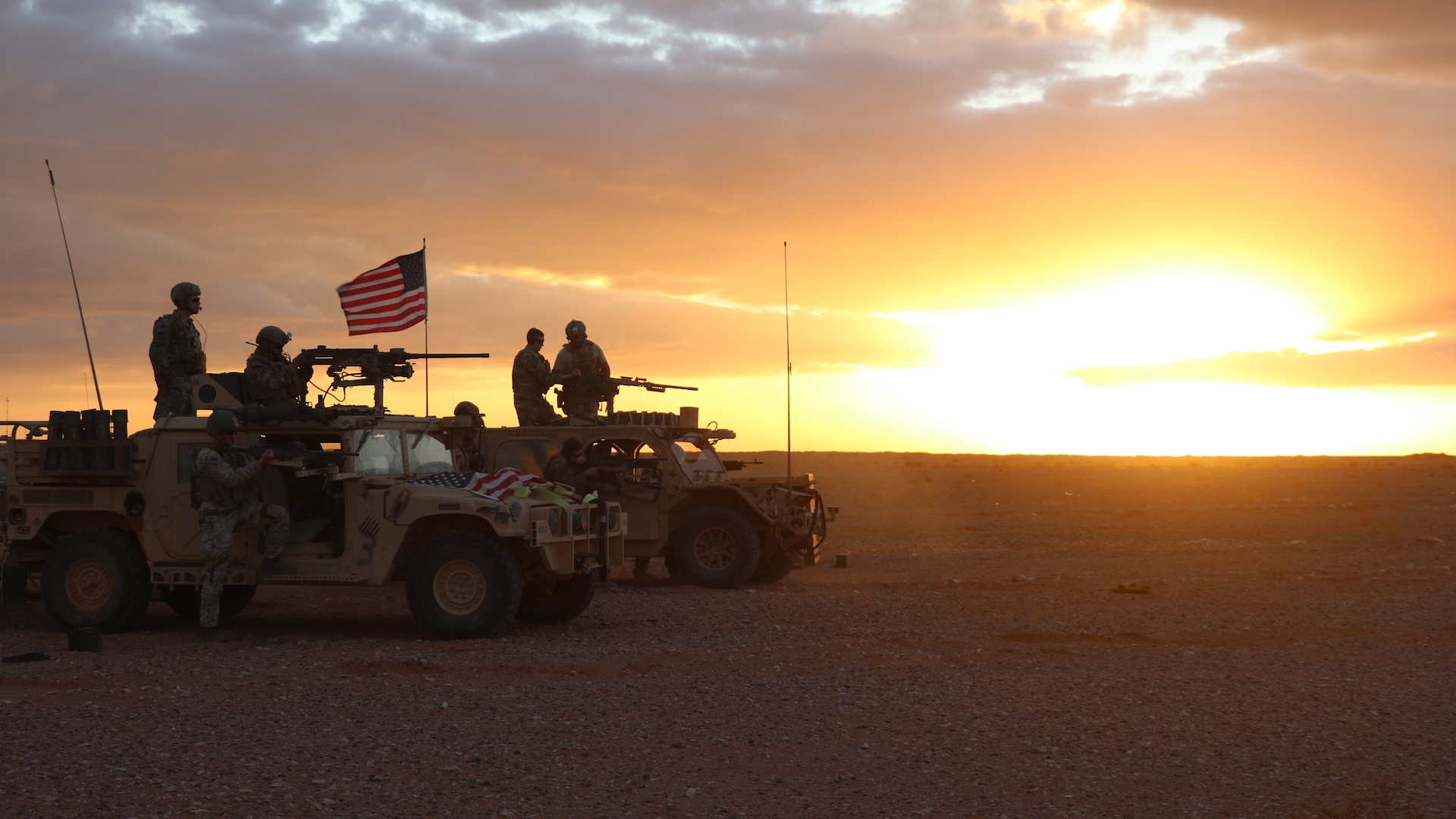

An escalating series of U.S. military airstrikes against sites linked to Iran’s Islamic Revolutionary Guard Corps, or IRGC, in Syria, have failed to stop further attacks against American forces in the region.
The Pentagon announced on Sunday that it had attacked a training facility and a safe house in Syria in response to a surge in drone and rocket attacks against U.S. troops since Oct. 17. That strike followed a hit on an ammo dump just days before.
Militias associated with the IRGC had been using the safehouse as a headquarters, and some of their members may have been killed by Sunday’s airstrike on the building, according to the Washington Post, which cited an unnamed senior defense official.
Since both U.S. airstrikes on Sunday, American troops in Syria have been attacked four additional times, a defense official told Task & Purpose. Three of those attacks occurred on Sunday and the most recent attack took place on Monday, Eastern Standard Time.
Subscribe to Task & Purpose Today. Get the latest military news and culture in your inbox daily.
As of Monday, U.S. troops in Syria have been attacked a total of 28 times and American service members in Iraq have come under attack on another 24 occasions for a total of at least 52 attacks overall, the official said.
Attacks against U.S. troops in Iraq and Syria have risen sharply since Hamas launched its Oct. 7 terror attack on Israel. Defense officials have repeatedly warned that Iran may be trying to escalate the conflict between Israel and Hamas by targeting American troops in the Middle East.
In response, the U.S. military launched airstrikes against the IRGC in Syria on Oct. 26, Nov. 8, and again on Sunday.

“By specifically targeting IRGC-associated facilities, we seek to convey a clear message to Iran that we hold it accountable for the attacks on U.S. forces, and we expect Iran to take measures to direct its proxies to stop,” a senior defense official told reporters on Nov. 8.
Despite the three rounds of airstrikes, Iranian-backed militias continue to be willing to accept the risks involved with attacking U.S. service members, said Nichols Carl, the Middle East Portfolio Manager at the American Enterprise Institute think tank in Washington, D.C.
“It isn’t entirely uncommon for us to see a flurry of Iranian-backed military activity in the immediate aftermath of a U.S. airstrike,” Carl told Task & Purpose.
Not only is Iran trying to prevent the United States from supporting Israel, but it has also launched a campaign for years to expel American troops from the Middle East, Carl said.
“I am very concerned that a lot of these attacks are meant to try to facilitate U.S. departure,” Carl said. “There’s all sorts of risks associated with this because, of course, we could get into an escalation cycle in Iraq or Syria. There’s a lot of bad scenarios that flow from there.”
There are several reasons why Iran has not been swayed by the U.S. military’s recent airstrikes to stop the attacks on American forces, said Behnam Ben Taleblu, an Iran expert at the Foundation for the Defense of Democracies think tank in Washington, D.C.
Iran’s goal is to use its proxies to create problems for the United States in the Middle East to prompt the U.S. government to pressure Israel to rein in its offensive against Hamas, said Taleblu, who noted that Iranian-backed Houthi rebels in Yemen have fired missiles at Israel and shot down a U.S. MQ-9 Reaper drone.
Even though many attacks against U.S. troops have been carried out by Iranian-backed militia groups inside Iraq, the American military has limited its airstrikes so far to Syria to avoid causing political turmoil for the government in Baghdad, Taleblu told Task & Purpose.
“One reason why these strikes are not likely to lead to a change in the regional security situation is that Iran and the militias assess there to be risk aversion, not risk tolerance,” Taleblu said. “Until that changes, until geographically you have to pay attention to what’s coming out of Iraq, this impression is likely to remain, if not – God forbid – cement, or conceal in the minds of Iran, the IRGC, and the Iran-backed militias.”
Taleblu also said that the number of attacks by Iranian-backed proxies dwarfs the number of airstrikes that the United States has conducted in response. Those airstrikes tend to be a reaction to attacks rather than proactive military action.
When the United States does strike back, it tends to undercut the effectiveness of its military actions by releasing statements that are crafted with domestic politics in mind, Taleblu said.
On Oct. 26, Defense Secretary Lloyd Austin said in a statement that U.S. airstrikes in Syria were “narrowly-tailored” in self-defense and that they were “separate and distinct” from the conflict between Israel and Hamas.
“That rhetorical tool politically drowns the military tool,” Taleblu said. “If you translate that messaging into Arabic and Persian, you shouldn’t also forget to translate the laughter that needs to follow it, because it is self-defeating.”
To end the current cycle of attacks on U.S. troops followed by American airstrikes, the United States needs to sanction more Iranian-backed militia groups, refine its messaging, and launch proactive airstrikes against arsenals and ammunition dumps used by groups associated with the IRGC rather than reacting to attacks on American forces, Taleblu said.
“This is going to take time,” Taleblu said.”It did not get like this overnight and it will not be fixed overnight. Republican or Democrat, this is going to take time.”
The latest on Task & Purpose
- The top 10 Army unit patches from glider units to PSYOP
- Troops and veterans don’t like ‘Thank You For Your Service’ — so what’s better?
- Military officers used prostitution ring that checked IDs, credit cards, employers
- Fort Liberty soldier arrested, faces 34 counts of sex crimes against minors
- Did a stimulant known as ‘the drug of jihad’ fuel Hamas terror on Oct. 7?
